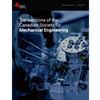Experimental on the FBC chamber for analysis temperature and combustion efficiency using palm oil biomass fuel
IF 1
4区 工程技术
Q4 ENGINEERING, MECHANICAL
Transactions of The Canadian Society for Mechanical Engineering
Pub Date : 2022-04-22
DOI:10.1139/tcsme-2021-0142
引用次数: 1
Abstract
Renewable energy sources such as palm oil biomass solid waste have attracted concern for scientists. This is because palm oil biomass is suitable to be converted as heat energy so that dependence on conventional fossil energy can be reduced. This study aims to analyze the combustion temperature and efficiency in fluidized-bed combustor (FBC) combustion chambers using oil palm biomass (such as palm kernel shell (PKS), empty fruit bunches (EFB), and oil palm midrib (OPM)). Besides, the remaining combustion ash from the testing process was analyzed using gaussian equations. The study conducted experiments through combustion in the FBC space. The result of experimentation from the combustion process with EFB fuel resulted in higher efficiency than OPM and PKS. The efficiency level of each fuel used is 12.77% EFB, 11.05% OPM, and PKS 10.63%. The analysis results for the highest temperatures were recorded from EFB fuels reaching 1,045oC. While the highest temperatures recorded from PKS and OPM were 875 oC and 934 oC, respectively, for measurements on M-1. As for the M-2 measurement the highest temperature was recorded on PKS fuel 935 oC, OPM 866 oC, and EFB 633 oC. Overall, the tests performed showed that the level of efficiency was in line with the testing process.使用棕榈油生物质燃料的FBC燃烧室实验分析温度和燃烧效率
棕榈油生物质固体废弃物等可再生能源引起了科学家们的关注。这是因为棕榈油生物质适合转化为热能,从而可以减少对传统化石能源的依赖。本研究旨在分析使用油棕生物质(如棕榈仁壳(PKS),空果束(EFB)和油棕中脉(OPM))的流化床燃烧室(FBC)的燃烧温度和效率。此外,利用高斯方程对试验过程中残余燃烧灰进行了分析。本研究在FBC空间进行了燃烧实验。实验结果表明,EFB燃料的燃烧效率高于OPM和PKS。使用的每种燃料的效率水平为12.77%的EFB, 11.05%的OPM和10.63%的PKS。分析结果显示,EFB燃料的最高温度为1045℃。而PKS和OPM在M-1上测得的最高温度分别为875摄氏度和934摄氏度。对于M-2测量,PKS燃料记录的最高温度为935 oC, OPM为866 oC, EFB为633 oC。总的来说,进行的测试表明,效率水平与测试过程是一致的。
本文章由计算机程序翻译,如有差异,请以英文原文为准。
求助全文
约1分钟内获得全文
求助全文
来源期刊
CiteScore
2.30
自引率
0.00%
发文量
53
审稿时长
5 months
期刊介绍:
Published since 1972, Transactions of the Canadian Society for Mechanical Engineering is a quarterly journal that publishes comprehensive research articles and notes in the broad field of mechanical engineering. New advances in energy systems, biomechanics, engineering analysis and design, environmental engineering, materials technology, advanced manufacturing, mechatronics, MEMS, nanotechnology, thermo-fluids engineering, and transportation systems are featured.

 求助内容:
求助内容: 应助结果提醒方式:
应助结果提醒方式:


